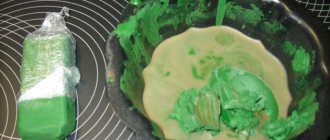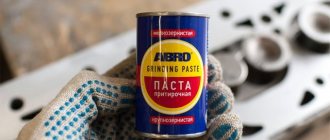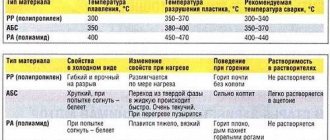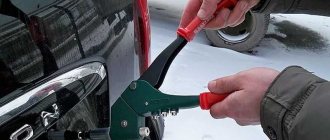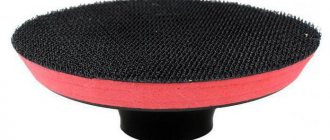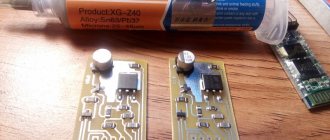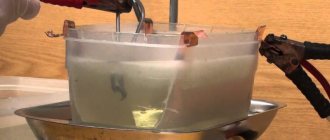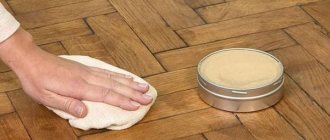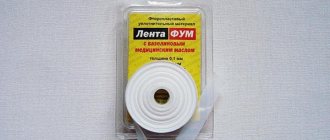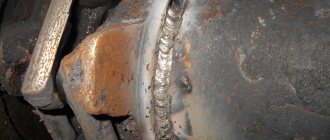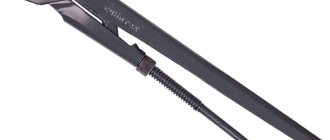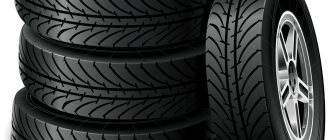GOI paste is one of the most popular means for polishing products made of various materials in our country. It is produced in the form of a green bar, similar to a soap bar, or in jars. It is worth noting that initially GOI paste was developed directly for grinding metal surfaces. But over time, its use spread to other areas of human activity. The product received its name in honor of the State Optical Institute, the enterprise where it was first obtained.
Classification and composition
The main compound in the GOI paste formula is chromium oxide. Its concentration affects the granularity of the substance and, accordingly, the performance characteristics. The higher the percentage of chromium oxide in the GOI paste, the rougher it is (varies from 60% to 85%). Depending on the grain size, there are several varieties, each of which is assigned an individual number:
- No. 1 - fine for final polishing and giving a mirror shine;
- No. 2 - thin to achieve a uniform matte surface;
- No. 3 - medium for removing small irregularities;
- No. 4 - rough to remove visible scratches.
Types of paste differ in composition, structure and color (from light green for fine to black and dark green for coarse).
In addition to chromium oxide, GOI paste contains fatty binding compounds, as well as activating components in the form of various solvents, adsorbents and other reagents, for example, silica gel, kerosene, stearin, bicarbonate of soda.
What materials can be polished with GOI paste?
The main purpose of GOI paste is the processing of metal products (stainless steel, cast iron, silver, aluminum, etc.), but it can also be used for polishing other surfaces: glass, plastics, ceramics, hard polymers. It is worth noting that this product has found wide application both in industry and in everyday life.
In everyday life, GOI paste is used for polishing kitchen knives, scissors or other products made of steel alloys. It is very popular among numismatists, who use it to remove corrosion from ancient coins and restore their shine. Fishermen use GOI paste to clean artificial fishing baits, increasing their specularity. Hunters use a mixture of this product to polish gun barrels.
How to use?
Apply GOI paste to the surface using a special polishing wheel or a soft cloth moistened with a solvent, for example, a rag or gauze. It should be remembered that the wetter the rag material, the longer the processing, but the better the result of the work done. It is possible to use kerosene, diesel fuel or other hard-to-evaporate, non-aggressive liquid as a solvent.
Polishing a product with GOI paste includes the following steps:
- Apply GOI paste to the rag material. It is strictly forbidden to add the product to the polished surface, as this may lead to the formation of new damage.
- Before grinding, to crush large particles, it is recommended to rub the product on a metal surface.
- To speed up the process, lightly treat the polished surface with liquid industrial oil.
- To avoid new scratches, polish with GOI paste without sudden movements or strong pressure. During the procedure, it is sometimes necessary to wipe the surface of the workpiece dry to control the quality of grinding.
- Upon completion of work, thoroughly rinse the product in solvent; if this is not possible, remove all signs of GOI paste from the surface with water.
Note
- ↑ Nesmelov S.V., Krylova T.N., Lavrov V.P.
Guide for workers in using GOI pastes for polishing hardened steel. - L.: GOI, 1934. - P. 3–6. - ↑ Nesmelov S.V.
How to use GOI pastes. With a preface acad. I. V. Grebenshchikova. - L.: GOI, 1936. - 31 p. - ↑ Nesmelov S.V.
Polishing metals with GOI pastes // Optical-mechanical industry. - 1939. - T. 9, No. 3. — pp. 11–13. - ↑ Vinokurov V.M.
Works of Academician I.V. Grebenshchikov in the field of polishing glass and metals and their development // Proceedings of GOI. - 1956. - T. 24, issue. 145. — pp. 310–338. - ↑ Sokolov S.P.
Chapter III. Finishing // Fine grinding and finishing / Under the general editorship. G. F. Kudasova. - issue 9. - L.: Leningrad branch of Mashgiz, 1961. - P. 52. - 87 p. — (Grinder's Library). — 15,000 copies.
Read also: What types of electric stoves are there for the kitchen?
| This is a preliminary article about the material. You can help the project by adding to it. |
What is Wiki.sc Wiki is the main information resource on the Internet. It is open to any user. Wiki is a library that is public and multilingual.
The basis of this page is on Wikipedia. The text is licensed under CC BY-SA 3.0 Unported License.
It doesn’t matter what you need: removing scratches from a knife blade, polishing the dim headlights of your car, or removing abrasions from the phone case - GOI paste will help you. Despite the differences in the listed materials and surfaces, the basic principles of using paste are almost the same. Follow the instructions.
GOI paste is the most popular polishing agent, since it can be used on various surfaces, from rough metals to glass and plastic.
Developed by the State Optical Institute (USSR) in the 30s of the last century and to this day, GOI paste remains an inexpensive and effective means for polishing almost any surface from a wide variety of materials.
Despite the ease of use of GOI paste, there are some small tricks that are worth paying attention to. But everything, as always, is simple. Look:
What do we need for polishing?
GOI paste: instructions for use
- Wet a cloth with gasoline or kerosene
A small amount of gasoline for lighters on a cloth - for better dissolution of GOI paste
- Apply GOI paste to the fabric
Rub a small amount of GOI paste, sufficient for polishing, into the fabric
Do not apply GOI paste directly to the surface you are going to polish.
- Lightly spray the surface to be treated with WD-40, which can be purchased at any automotive store.
Apply WD-40, spindle or any industrial oil directly to the surface to be polished
- Use a cloth to polish the surface in a circular motion until you achieve the desired result.
Polish the surface until the desired result is obtained, periodically wetting the surface with WD-40
Do not put too much pressure on the surface being treated, as this may lead to the opposite result.
- At the end of the work, rinse the surface to be treated and wipe it dry.
GOI paste: granularity
GOI paste differs in its grain size and is presented in our store under the numbers: 1, 2, 3 and 4, i.e. from fine to coarse, as well as in sets, which can be purchased at a discount.
GOI paste in a set from number 1 to number 4
- Coarse No. 4 is the most effective in terms of the volume of material removed. Gives the polished product a matte surface
Coarse paste GOI No. 4
- Medium No. 3 - gives a clean surface
Medium paste GOI No. 3
- Small No. 1 and No. 2 - for fine finishing; gives the product a mirror shine
Fine-grain pastes No. 1 and No. 2
Use GOI coarse paste to remove deep scratches and fine paste for final polishing.
I recommend purchasing GOI paste in a set and not only in order to save money. Polished surfaces and scratches on them may vary. You can always independently determine which number of GOI paste is needed at a particular moment and use it for polishing.
Video instructions for removing scratches from a knife blade
The video was filmed a long time ago. Make a discount on the quality of shooting. We will update in the coming days.
Features of polishing products made from various materials
It is important to note that products made from various materials require a certain polishing technology with GOI paste. First of all, it is necessary to select the type of technical means and fabric with which the surface will be treated. After this, in order to get the maximum result and prevent the formation of new damage, you should decide on the polishing process,
- For polishing glass and plastic, it is recommended to choose GOI No2 paste and a soft-pile cloth, such as cotton or flannel. In this case, the product must be generously rubbed onto a piece of rag material, and the surface of the product must be cleaned of debris and dust. After the preparatory work, you can begin polishing the surface. To do this, it is necessary to grind the product for several minutes without brute force, applying light pressure. It is worth noting that when processing the screen of a mobile phone or watch, you must carefully use solvents and oil so that they do not penetrate inside the case.
- Silver jewelry tends to lose its original shine over time. Correct use of GOI paste No. 3 will help restore the appearance of products. As a processing fabric, you should choose a material with a more rigid structure, for example, a tarpaulin or felt circle, or a piece of felt boots. After applying GOI paste to the fabric, you must thoroughly rub the product against it, completely covering the darkened surface. The final step is to polish the jewelry with a softer cloth until the final shine is obtained. To achieve the greatest effect, before starting polishing, it is recommended to boil silver products in a solution mixed from: 300 ml of water; 2 teaspoons of an aqueous solution of ammonium hydroxide; 50 g grated soap; 50 g washing powder.
- To polish knives or scissors, GOI paste is applied to a wooden block. You can also glue sandpaper to the board and rub it with this technical product, slightly moistened with a solvent. Then the steel alloy products should be ground against a block using a reciprocating motion at different angles.
How to use GOI paste
Each package comes with instructions that describe in detail the composition of the GOI paste, the rules for use in direct contact with certain hard surfaces to eliminate defects. Before starting use, you need to decide which paste will be relevant in a particular case. Several practical options predominate on free sale, among them the following numbers:
- No. 4. For rough processing.
- No. 3. To provide a matte surface without streaks.
- No. 2 and 1. To ensure glossy surfaces.
The procedure itself is not complicated, the main thing is to strictly follow the general recommendations and not damage the surface being treated. Polishing with GOI paste can be carried out in the following sequence:
- To avoid scratches on the surface being treated, you must first find a piece of cloth, such as flannel, and soak it in gasoline.
- Apply a small amount of paste to a rag, then wipe it on an unnecessary metal object to break up large crystals of the GOI composition.
- Rub the object with gentle movements until its body begins to shine. This cleaning takes a few minutes, but it is important to beware of large particles of Goya composition and scratches.
- After completing the session, you need to additionally treat the surface with gasoline or dip the polished object in kerosene.
For metal
Before polishing with GOI paste, it is important to decide on the type of metal. For example, there is often a need for high-quality cleaning of silver cutlery - forks, knives, spoons (over time they darken and turn green). In this case, it is important not to spoil the surface of the noble metal with small scratches, but to act in the sequence given below:
- Wash silver cutlery.
- Rub with a toothbrush and powder until shiny.
- Separately, pour water into a glass, add a little ammonia, soap, powder.
- Boil cutlery in this composition.
- Then proceed to metal processing with GOI composition.
If we talk about other metal bases and products, it is worth emphasizing that steel items are cleaned using a special device, and it is better to completely abandon cleaning gold in this way. This is explained by the fact that the top layer of this precious metal can be erased. When polishing a metal watch with paste, it is important to first remove the watch mechanism.
- Painkillers - list
- How to increase blood pressure during pregnancy without medications
- Angiography of cerebral vessels
For glass
For example, you may need to polish the display of a mobile phone or any other gadget. In this case, you definitely can’t do without this miraculous paste. When working with glass surfaces, it is recommended to use GOI composition No. 2, and additionally use a soft flannel rag. The cleaning process is available at home, the sequence of actions is as follows:
- Take a piece of rag and rub it thoroughly with a bar of technical product so that a layer of paste remains.
- After this, you can begin high-quality grinding of the glass, but do not put too much pressure on the fragile product.
- Without much effort, in just a few minutes the glass surface will be polished to a shine.
For plastic
For plastics, it is also recommended to use the GOI composition No. 2 with a viscous or solid consistency. Take a rag again and rub it with a bar or apply a thin layer of a gel-like paste. In the latter case, before proceeding with more intensive sanding of the plastic, it is important to rub any metal surface (to avoid scratches on the plastic). Then use the technical tool for its intended purpose in the same way as the examples described above.
What products cannot be polished with GOI paste?
It is worth remembering that polishing products made from some materials with GOI paste may be ineffective or even cause damage to the appearance. It is not recommended to process with this technical means:
- gold-plated products (the outer layer can be erased);
- steel, except for knives and scissors, and nickel (as a rule, they are not polished by hand, but with a special tool);
- metal watches (can be polished with the mechanism removed);
- sapphire watch crystals (grinding with GOI paste is ineffective).
WHAT TO DIVIDE
Before use, GOI polishing paste requires preliminary softening. In its initial state, the paste can be quite dry, which will make it difficult to apply to a polishing cloth, and hard lumps will lead to the formation of unnecessary scratches on the glass during processing.
The list of liquids used to soften the material is quite extensive: from distilled water, industrial and motor oils to white spirit and purified gasoline for lighters.
It is not recommended to dissolve GOI paste with gasoline or white spirit due to their flammability, and then it is difficult to neutralize the specific pungent odor of these liquids. The following method is more practical:
- Apply a small amount of motor oil to a block of GOI solid paste using a syringe or pipette;
- the liquid is rubbed into the block using flannel or cotton cloth until the paste has a consistency similar to plasticine;
- With the resulting plastic mass, you can polish defective areas of glass or headlights without the risk of damage.
For greater homogeneity, the mixture of GOI paste with motor oil can be heated before use (for example, in the microwave) and mixed thoroughly.
The glass or plastic surface to be treated must also be moistened with water and lubricated with industrial or motor oil. If you apply GOI paste on dry glass, there is a high probability that the outer layer will become dull.
Harmful to humans?
Concerns are often raised that the chromium oxide contained in GOI paste is toxic. These judgments are justified, since a given compound, depending on its valency, can exhibit different properties. Hexavalent chromium oxide is toxic and hazardous to human health. Meanwhile, in the production of GOI paste, a non-toxic trivalent compound that has passed examination is used.
At the same time, excluding the harmfulness of GOI paste to human health, it is recommended to use protective glasses and a mask when using it. This is due to the fact that when polishing products, dust is generated, which can cause irritation of the mucous membranes.
